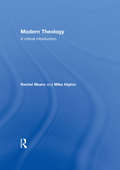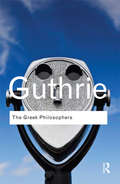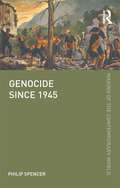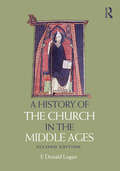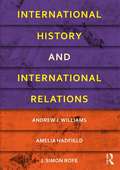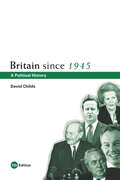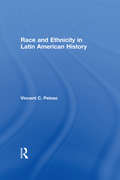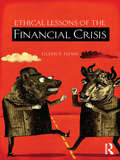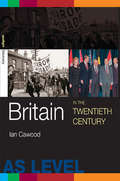- Table View
- List View
Modern Theology: A Critical Introduction
by Rachel Muers Mike HigtonThis book offers a fresh and up-to-date introduction to modern Christian theology. The ‘long nineteenth century’ saw enormous transformations of theology, and of thought about religion, that shaped the way both Christianity and ‘religion’ are understood today. Muers and Higton provide a lucid guide to the development of theology since 1789, giving students a critical understanding of their own ‘modern’ assumptions, of the origins of the debates and the fields of study in which they are involved, and of major modern thinkers. Modern Theology: introduces the context and work of a selection of major nineteenth-century thinkers who decisively affected the shape of modern theology presents key debates and issues that have their roots in the nineteenth century but are also central to the study of twentieth- and twenty-first-century theology includes exercises and study materials that explicitly focus on the development of core academic skills. This valuable resource also contains a glossary, timeline, annotated bibliographies and illustrations.
The Greek Philosophers: from Thales to Aristotle
by W. K. GuthrieWith an new foreword by James Warren Long renowned as one of the clearest and best introductions to ancient Greek philosophy for non-specialists, W.K.C Guthrie’s The Greek Philosophers offers us a brilliant insight into the hidden foundations of Greek philosophy – foundations that underpin Western thought today. Guthrie explores the great age of Greek Philosophy – from Thales to Aristotle – whilst combining comprehensiveness with brevity. He unpacks the ideas and arguments of Plato and Aristotle in the light of their predecessors rather than their successors and describes the characteristic features of the Greek way of thinking, emphasising what he calls the ‘cultural soil’ of their ideas. He also highlights the achievements of thinkers such as Pythagoras, who in contemporary accounts of Greek philosophy are frequently overlooked. Combining philosophical insight and historical sensitivity, The Greek Philosophers offers newcomers a brilliant introduction to the greatest thinkers in ancient Greek philosophy and the very origins of Western thought.
The Greek Philosophers: from Thales to Aristotle
by W. K. GuthrieWith an new foreword by James Warren Long renowned as one of the clearest and best introductions to ancient Greek philosophy for non-specialists, W.K.C Guthrie’s The Greek Philosophers offers us a brilliant insight into the hidden foundations of Greek philosophy – foundations that underpin Western thought today. Guthrie explores the great age of Greek Philosophy – from Thales to Aristotle – whilst combining comprehensiveness with brevity. He unpacks the ideas and arguments of Plato and Aristotle in the light of their predecessors rather than their successors and describes the characteristic features of the Greek way of thinking, emphasising what he calls the ‘cultural soil’ of their ideas. He also highlights the achievements of thinkers such as Pythagoras, who in contemporary accounts of Greek philosophy are frequently overlooked. Combining philosophical insight and historical sensitivity, The Greek Philosophers offers newcomers a brilliant introduction to the greatest thinkers in ancient Greek philosophy and the very origins of Western thought.
American Education: A History
by Jennings L. Wagoner Jr. Wayne J. UrbanAmerican Education: A History, 5e is a comprehensive, highly-regarded history of American education from pre-colonial times to the present. Chronologically organized, it provides an objective overview of each major period in the development of American education, setting the discussion against the broader backdrop of national and world events. The first text to explore Native American traditions (including education) prior to colonization, it also offers strong, ongoing coverage of minorities and women. New to this much-anticipated fifth edition is substantial expanded attention to the discussions of Native American education to reflect recent scholarship, the discussion of teachers and teacher leaders, and the educational developments and controversies of the 21st century.
American Education: A History
by Jennings L. Wagoner Jr. Wayne J. UrbanAmerican Education: A History, 5e is a comprehensive, highly-regarded history of American education from pre-colonial times to the present. Chronologically organized, it provides an objective overview of each major period in the development of American education, setting the discussion against the broader backdrop of national and world events. The first text to explore Native American traditions (including education) prior to colonization, it also offers strong, ongoing coverage of minorities and women. New to this much-anticipated fifth edition is substantial expanded attention to the discussions of Native American education to reflect recent scholarship, the discussion of teachers and teacher leaders, and the educational developments and controversies of the 21st century.
Bringing History Alive through Local People and Places: A guide for primary school teachers
by Lynne Dixon Alison HalesA much-needed and delightful book. It shows how history can be taught with the meaningful experiences of each child at its centre, making connections between the child, the locality and community, the national and global past and concepts of time. Throughout the authors empower teachers to adopt their philosophy, by showing them how to plan, select resources and strategies and reflect on ideas and case studies. Hilary Cooper, Emeritus professor of history and pedagogy, The University of Cumbria, UK. Bringing History Alive through Local People and Places puts the local environment and community at the heart of history, showing how it can be used as the context for successful history teaching across the primary age range. It considers how to develop children’s concepts and skills through local history, how to link local, national and global aspects of history, and helps you develop your own historical knowledge, understanding and confidence in teaching the subject. Practical topics explored include: Investigating children’s cultural and geographical roots through fieldwork Finding and visiting local museums, archives and heritage sights Choosing and using resources Using significant people, events and buildings to link with national history Environmental education and sustainable development through local history Understanding the links between history and everyday life Planning and assessing history. Based on the latest research and practice in the field, Bringing History Alive through Local People and Places offers an exciting template of creative ideas and activities to show teachers how they can make history relevant to all children.
Bringing History Alive through Local People and Places: A guide for primary school teachers
by Lynne Dixon Alison HalesA much-needed and delightful book. It shows how history can be taught with the meaningful experiences of each child at its centre, making connections between the child, the locality and community, the national and global past and concepts of time. Throughout the authors empower teachers to adopt their philosophy, by showing them how to plan, select resources and strategies and reflect on ideas and case studies. Hilary Cooper, Emeritus professor of history and pedagogy, The University of Cumbria, UK. Bringing History Alive through Local People and Places puts the local environment and community at the heart of history, showing how it can be used as the context for successful history teaching across the primary age range. It considers how to develop children’s concepts and skills through local history, how to link local, national and global aspects of history, and helps you develop your own historical knowledge, understanding and confidence in teaching the subject. Practical topics explored include: Investigating children’s cultural and geographical roots through fieldwork Finding and visiting local museums, archives and heritage sights Choosing and using resources Using significant people, events and buildings to link with national history Environmental education and sustainable development through local history Understanding the links between history and everyday life Planning and assessing history. Based on the latest research and practice in the field, Bringing History Alive through Local People and Places offers an exciting template of creative ideas and activities to show teachers how they can make history relevant to all children.
Genocide since 1945
by Philip SpencerIn 1948 the United Nations passed the Genocide Convention. The international community was now obligated to prevent or halt what had hitherto, in Winston Churchill’s words, been a "crime without a name", and to punish the perpetrators. Since then, however, genocide has recurred repeatedly. Millions of people have been murdered by sovereign nation states, confident in their ability to act with impunity within their own borders. Tracing the history of genocide since 1945, and looking at a number of cases across continents and decades, this book discusses a range of critical and inter-connected issues such as: why this crime is different, why exactly it is said to be "the crime of crimes" how each genocide involves a deadly triangle of perpetrators (with their collaborators), victims and bystanders as well as rescuers the different stages that genocides go through, from conception to denial the different explanations that have been put forward for why genocide takes place and the question of humanitarian intervention. Genocide since 1945 aims to help the reader understand how, when, where and why this crime has been committed since 1945, why it has proven so difficult to halt or prevent its recurrence, and what now might be done about it. It is essential reading for all those interested in the contemporary world.
Genocide since 1945
by Philip SpencerIn 1948 the United Nations passed the Genocide Convention. The international community was now obligated to prevent or halt what had hitherto, in Winston Churchill’s words, been a "crime without a name", and to punish the perpetrators. Since then, however, genocide has recurred repeatedly. Millions of people have been murdered by sovereign nation states, confident in their ability to act with impunity within their own borders. Tracing the history of genocide since 1945, and looking at a number of cases across continents and decades, this book discusses a range of critical and inter-connected issues such as: why this crime is different, why exactly it is said to be "the crime of crimes" how each genocide involves a deadly triangle of perpetrators (with their collaborators), victims and bystanders as well as rescuers the different stages that genocides go through, from conception to denial the different explanations that have been put forward for why genocide takes place and the question of humanitarian intervention. Genocide since 1945 aims to help the reader understand how, when, where and why this crime has been committed since 1945, why it has proven so difficult to halt or prevent its recurrence, and what now might be done about it. It is essential reading for all those interested in the contemporary world.
A History of the Church in the Middle Ages
by F Donald Logan"Conceptually well organized, stylistically clear, intellectually thoughtful, and pedagogically useful." - Thomas Head, Speculum "For its humane and learned approach to its enormous canvas, as well as for the cogency with which it penetrates at speed to the essentials of a vanished historical epoch, this History of the Church in the Middle Ages deserves a very wide audience indeed." - Barrie Dobson, English Historical Review "To have written a scholarly and very readable history of the Western Church over a millennium is a remarkable tour de force, for which Donald Logan is to be warmly congratulated." - C.H Lawrence, The Tablet "A feat of historical synthesis, most confident in its telling of the coming of Christianity. Books like Logan's are needed more than ever before." - Miri Rubin, TLS In this fascinating survey, F. Donald Logan introduces the reader to the Christian church, from the conversion of the Celtic and Germanic peoples to the discovery of the New World. He reveals how the church unified the people of Western Europe as they worshipped with the same ceremonies and used Latin as the language of civilized communication. From remote, rural parish to magnificent urban cathedral, A History of the Church in the Middle Ages explores the role of the church as a central element in determining a thousand years of history. This new edition brings the book right up to date with recent scholarship, and includes an expanded introduction exploring the interaction of other faiths - particularly Judaism and Islam - with the Christian church.
A History of the Church in the Middle Ages
by F Donald Logan"Conceptually well organized, stylistically clear, intellectually thoughtful, and pedagogically useful." - Thomas Head, Speculum "For its humane and learned approach to its enormous canvas, as well as for the cogency with which it penetrates at speed to the essentials of a vanished historical epoch, this History of the Church in the Middle Ages deserves a very wide audience indeed." - Barrie Dobson, English Historical Review "To have written a scholarly and very readable history of the Western Church over a millennium is a remarkable tour de force, for which Donald Logan is to be warmly congratulated." - C.H Lawrence, The Tablet "A feat of historical synthesis, most confident in its telling of the coming of Christianity. Books like Logan's are needed more than ever before." - Miri Rubin, TLS In this fascinating survey, F. Donald Logan introduces the reader to the Christian church, from the conversion of the Celtic and Germanic peoples to the discovery of the New World. He reveals how the church unified the people of Western Europe as they worshipped with the same ceremonies and used Latin as the language of civilized communication. From remote, rural parish to magnificent urban cathedral, A History of the Church in the Middle Ages explores the role of the church as a central element in determining a thousand years of history. This new edition brings the book right up to date with recent scholarship, and includes an expanded introduction exploring the interaction of other faiths - particularly Judaism and Islam - with the Christian church.
International History and International Relations
by Andrew J. Williams Amelia Hadfield J. Simon RofeThis innovative new textbook seeks to provide undergraduate students of international relations with valuable and relevant historical context, bridging the gap and offering a genuinely interdisciplinary approach. Each chapter integrates both historical analysis and literature and applies this to an international relations context in an accessible fashion, allowing students to understand the historical context in which these core issues have developed. The book is organised thematically around the key issues in international relations such as war, peace, sovereignty, identity, empire and international organisations. Each chapter provides an overview of the main historical context, theories and literature in each area and applies this to the study of international relations. Providing a fresh approach, this work will be essential reading for all students of international relations and international relations theory.
International History and International Relations
by Andrew J. Williams Amelia Hadfield J. Simon RofeThis innovative new textbook seeks to provide undergraduate students of international relations with valuable and relevant historical context, bridging the gap and offering a genuinely interdisciplinary approach. Each chapter integrates both historical analysis and literature and applies this to an international relations context in an accessible fashion, allowing students to understand the historical context in which these core issues have developed. The book is organised thematically around the key issues in international relations such as war, peace, sovereignty, identity, empire and international organisations. Each chapter provides an overview of the main historical context, theories and literature in each area and applies this to the study of international relations. Providing a fresh approach, this work will be essential reading for all students of international relations and international relations theory.
Britain since 1945: A Political History
by David ChildsBritain since 1945 is the established textbook on contemporary British political history since the end of the Second World War. David Childs' authoritative chronological survey discusses domestic policy and politics in particular, but also covers external and international relations. This new and improved seventh edition of this important book brings the picture to the present by including the following additions: Tony Blair's resignation and Gordon Brown's accession to power immigration the financial crisis from 2007: the first bank run in Britain since 1866 the 'Special-relationship' with the US and Obama the 2010 General elcetion and the first coalition government since 1945 'Broken Britain' and Crime the era of ‘owned by China' and Britain’s place in a turbulent world. Britain since 1945 is essential reading for any student of contemporary British history and politics.
Britain since 1945: A Political History
by David ChildsBritain since 1945 is the established textbook on contemporary British political history since the end of the Second World War. David Childs' authoritative chronological survey discusses domestic policy and politics in particular, but also covers external and international relations. This new and improved seventh edition of this important book brings the picture to the present by including the following additions: Tony Blair's resignation and Gordon Brown's accession to power immigration the financial crisis from 2007: the first bank run in Britain since 1866 the 'Special-relationship' with the US and Obama the 2010 General elcetion and the first coalition government since 1945 'Broken Britain' and Crime the era of ‘owned by China' and Britain’s place in a turbulent world. Britain since 1945 is essential reading for any student of contemporary British history and politics.
Race and Ethnicity in Latin American History
by Vincent PelosoThe Spanish and Portuguese empires that existed in the Americas for over three hundred years resulted in the creation of a New World population in which a complex array of racial and ethnic distinctions were embedded in the discourse of power. During the colonial era, racial and ethnic identities were publicly acknowledged by the state and the Church, and subject to stringent codes that shaped both individual lives and the structures of society. The legacy of these distinctions continued after independence, as race and ethnicity continued to form culturally defined categories of social life. In Race and Ethnicity in Latin American History, Vincent Peloso traces the story of ethnicity and race in Latin America from the sixteenth century to the contemporary period. In a short, synthetic narrative, he lays the groundwork for students to understand how the history of colonial racism is connected to the problems of racism in today’s Latin American societies. With features including timelines, plentiful maps and illustrations, and boxes highlighting important historical figures, the text provides a clear and accessible introduction to the complex subject of race and ethnicity in the history of Latin America.
Race and Ethnicity in Latin American History
by Vincent PelosoThe Spanish and Portuguese empires that existed in the Americas for over three hundred years resulted in the creation of a New World population in which a complex array of racial and ethnic distinctions were embedded in the discourse of power. During the colonial era, racial and ethnic identities were publicly acknowledged by the state and the Church, and subject to stringent codes that shaped both individual lives and the structures of society. The legacy of these distinctions continued after independence, as race and ethnicity continued to form culturally defined categories of social life. In Race and Ethnicity in Latin American History, Vincent Peloso traces the story of ethnicity and race in Latin America from the sixteenth century to the contemporary period. In a short, synthetic narrative, he lays the groundwork for students to understand how the history of colonial racism is connected to the problems of racism in today’s Latin American societies. With features including timelines, plentiful maps and illustrations, and boxes highlighting important historical figures, the text provides a clear and accessible introduction to the complex subject of race and ethnicity in the history of Latin America.
Ethical Lessons of the Financial Crisis
by Eileen P. FlynnIn the aftermath of the economic crisis of 2008 it is important to ask what ethics has to say to the many stakeholders in the U.S. economy. The crisis in the financial industry, precipitated by the bursting of a bubble in the housing sector, brought the U.S. economy to the brink of a major depression. Government officials, economists and financial executives intervened to implement measures to mitigate the damage, applying their expertise and using their best judgments to rescue the economy. The actions they took required technical competence, pragmatic judgments and controversial decisions. They worked through a crisis to try to prevent a very bad situation from becoming a catastrophe. As events played out in the autumn of 2008, there was little time to reflect on how immoral conduct contributed to the crisis and how financial recovery needs to be built on an ethical foundation. The purpose of this book is to examine the role of ethics in setting things right. In taking a close look at the events of 2008 this book makes an important contribution to business ethics.
Ethical Lessons of the Financial Crisis
by Eileen P. FlynnIn the aftermath of the economic crisis of 2008 it is important to ask what ethics has to say to the many stakeholders in the U.S. economy. The crisis in the financial industry, precipitated by the bursting of a bubble in the housing sector, brought the U.S. economy to the brink of a major depression. Government officials, economists and financial executives intervened to implement measures to mitigate the damage, applying their expertise and using their best judgments to rescue the economy. The actions they took required technical competence, pragmatic judgments and controversial decisions. They worked through a crisis to try to prevent a very bad situation from becoming a catastrophe. As events played out in the autumn of 2008, there was little time to reflect on how immoral conduct contributed to the crisis and how financial recovery needs to be built on an ethical foundation. The purpose of this book is to examine the role of ethics in setting things right. In taking a close look at the events of 2008 this book makes an important contribution to business ethics.
Sexuality in Medieval Europe: Doing Unto Others
by Ruth Mazo Karras‘The best short introduction to medieval sexuality that I have read: a remarkable book.’ -Vern Bullough, Reviews in History 'Undergraduate and graduate students will find in Karras’ book an extremely helpful guide to what can be a confusing and perplexing body of scholarship. Even established scholars are likely to find it enlightening as well as enjoyable.' - James Brundage, Journal of Ecclesiastical History ‘An impressively synthetic and highly readable survey of current scholarship on medieval sexuality that will be of considerable use in undergraduate and postgraduate teaching.’ - Emma Campbell, Signs Sexuality in medieval Europe has become a vital scholarly field that is now recognized as central to the study of the Middle Ages. Using a wide collection of evidence from the late Antique period up until the fifteenth century, this new edition of the standard overview on the topic demonstrates that medieval culture developed sexual identities that were quite different from the identities we think of today, yet that were still in some ways ancestral to our own. Challenging the way the Middle Ages have been treated in general histories of sexuality, Ruth Mazo Karras shows how views at the time were conflicted and complicated; there was no single medieval attitude towards sexuality any more than there is one modern attitude. The well-known lusty priest and the ‘repressed’ penitent have their roles to play, but set here in a wider context these figures take on fascinating new dimensions. Focusing on acceptable marital sexual activity as well as what was seen as transgressive, the chapters cover such topics as chastity, the role of the church, and non-reproductive activity. Combining an overview of research on the topic with original interpretations, now updated with the latest scholarship and additional material from medieval Christian Europe, Jewish medieval culture and the Islamic world, Sexuality in Medieval Europe is essential reading for all those who study medieval history and culture, or who have an interest in the way sexuality and sexual identity have been viewed in the past.
Sexuality in Medieval Europe: Doing Unto Others
by Ruth Mazo Karras‘The best short introduction to medieval sexuality that I have read: a remarkable book.’ -Vern Bullough, Reviews in History 'Undergraduate and graduate students will find in Karras’ book an extremely helpful guide to what can be a confusing and perplexing body of scholarship. Even established scholars are likely to find it enlightening as well as enjoyable.' - James Brundage, Journal of Ecclesiastical History ‘An impressively synthetic and highly readable survey of current scholarship on medieval sexuality that will be of considerable use in undergraduate and postgraduate teaching.’ - Emma Campbell, Signs Sexuality in medieval Europe has become a vital scholarly field that is now recognized as central to the study of the Middle Ages. Using a wide collection of evidence from the late Antique period up until the fifteenth century, this new edition of the standard overview on the topic demonstrates that medieval culture developed sexual identities that were quite different from the identities we think of today, yet that were still in some ways ancestral to our own. Challenging the way the Middle Ages have been treated in general histories of sexuality, Ruth Mazo Karras shows how views at the time were conflicted and complicated; there was no single medieval attitude towards sexuality any more than there is one modern attitude. The well-known lusty priest and the ‘repressed’ penitent have their roles to play, but set here in a wider context these figures take on fascinating new dimensions. Focusing on acceptable marital sexual activity as well as what was seen as transgressive, the chapters cover such topics as chastity, the role of the church, and non-reproductive activity. Combining an overview of research on the topic with original interpretations, now updated with the latest scholarship and additional material from medieval Christian Europe, Jewish medieval culture and the Islamic world, Sexuality in Medieval Europe is essential reading for all those who study medieval history and culture, or who have an interest in the way sexuality and sexual identity have been viewed in the past.
Managing World Heritage Sites
by Anna Leask Alan FyallWorld Heritage Sites are some of the most recognised locations around the world. They include natural sites such as the Grand Canyon and the Great Barrier and cultural ones such as the Pyramids at Giza, the Walled City of Baku in Azerbaijan and the Historic Centre of Riga in Latvia. The responsibility to manage them successfully and ensure that the resources are not damaged by visitors, war or environment is therefore vital. Managing World Heritage Sites covers the management issues encountered at cultural and natural UNESCO World Heritage Sites). WHS sites are high profile and as their designation states they are unique. They are often government owned and subject to political debate, they have iconic status and are therefore crucial to national tourism industries, and often involve a large number of stakeholders within their management structures. This text considers all of these aspects in arriving at solutions for site management principles. In 12 chapters and 5 case studies it covers issues such as WHS designation, marketing, visitor management, revenue generation and management. Each chapter will examine the management issues associated with managing heritage within the WH Sites, making clear use of management practices to apply the theory. Managing World Heritage Sites: • Includes international case studies such as World Heritage Sites in the Americas, Machupicchu, Stonehenge, Central Eastern Rainforest Reserves of Australia, Megalithic Temples of Malta.• Is authored by an international contributor team of well known and respected experts in this field • Has a user friendly and logical structure including aims, introduction, case study, conclusion, references and websites and examples best practice. • 5 specific case study chapters including a location map, an explanation of key issues, conclusion, and questions for self-study
Managing World Heritage Sites
by Anna Leask Alan FyallWorld Heritage Sites are some of the most recognised locations around the world. They include natural sites such as the Grand Canyon and the Great Barrier and cultural ones such as the Pyramids at Giza, the Walled City of Baku in Azerbaijan and the Historic Centre of Riga in Latvia. The responsibility to manage them successfully and ensure that the resources are not damaged by visitors, war or environment is therefore vital. Managing World Heritage Sites covers the management issues encountered at cultural and natural UNESCO World Heritage Sites). WHS sites are high profile and as their designation states they are unique. They are often government owned and subject to political debate, they have iconic status and are therefore crucial to national tourism industries, and often involve a large number of stakeholders within their management structures. This text considers all of these aspects in arriving at solutions for site management principles. In 12 chapters and 5 case studies it covers issues such as WHS designation, marketing, visitor management, revenue generation and management. Each chapter will examine the management issues associated with managing heritage within the WH Sites, making clear use of management practices to apply the theory. Managing World Heritage Sites: • Includes international case studies such as World Heritage Sites in the Americas, Machupicchu, Stonehenge, Central Eastern Rainforest Reserves of Australia, Megalithic Temples of Malta.• Is authored by an international contributor team of well known and respected experts in this field • Has a user friendly and logical structure including aims, introduction, case study, conclusion, references and websites and examples best practice. • 5 specific case study chapters including a location map, an explanation of key issues, conclusion, and questions for self-study
Britain in the Twentieth Century
by Ian J. CawoodBritain in the Twentieth Century is a new approach to teaching and learning twentieth century British history at A level. It meets the needs of teachers and students studying for today's revised AS and A2 exams. In a unique style, Britain in the Twentieth Century focuses on the key topics within the period. Each topic is then comprehensively explored to provide background, essay writing advice and examples, source work and historical skills. From 1900 to the new millennium, the key topics featured include:* Britain in a new century, 1900-1914* the First World War and its impact* inter-war domestic problems* British foreign policy, 1919-1939* Britain and the Second World War* social and economic change, 1945-1979.
Britain in the Twentieth Century
by Ian J. CawoodBritain in the Twentieth Century is a new approach to teaching and learning twentieth century British history at A level. It meets the needs of teachers and students studying for today's revised AS and A2 exams. In a unique style, Britain in the Twentieth Century focuses on the key topics within the period. Each topic is then comprehensively explored to provide background, essay writing advice and examples, source work and historical skills. From 1900 to the new millennium, the key topics featured include:* Britain in a new century, 1900-1914* the First World War and its impact* inter-war domestic problems* British foreign policy, 1919-1939* Britain and the Second World War* social and economic change, 1945-1979.
